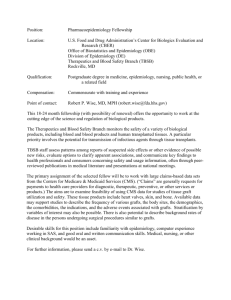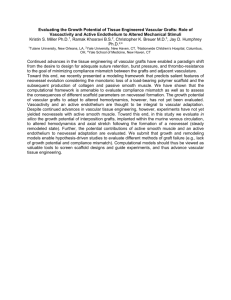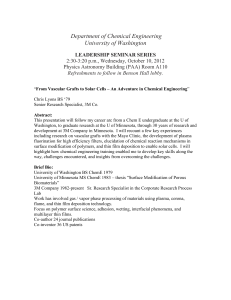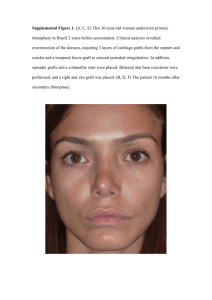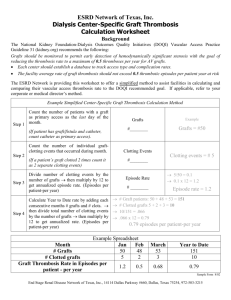ST524F08_Exam2.doc
advertisement
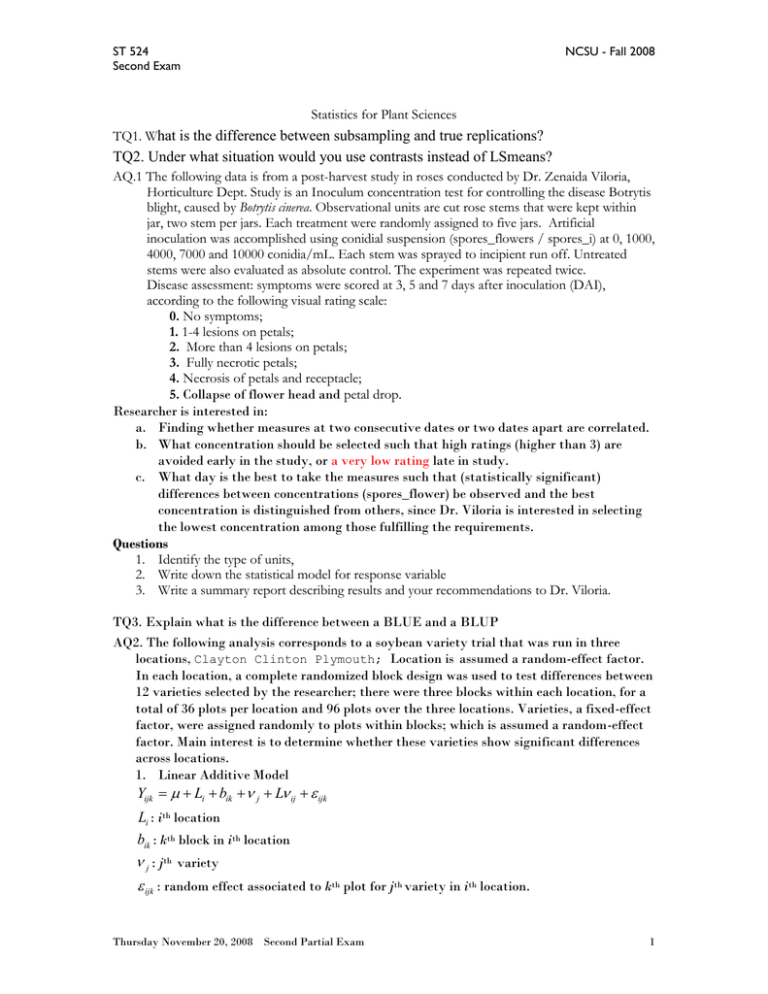
ST 524 Second Exam NCSU - Fall 2008 Statistics for Plant Sciences TQ1. What is the difference between subsampling and true replications? TQ2. Under what situation would you use contrasts instead of LSmeans? AQ.1 The following data is from a post-harvest study in roses conducted by Dr. Zenaida Viloria, Horticulture Dept. Study is an Inoculum concentration test for controlling the disease Botrytis blight, caused by Botrytis cinerea. Observational units are cut rose stems that were kept within jar, two stem per jars. Each treatment were randomly assigned to five jars. Artificial inoculation was accomplished using conidial suspension (spores_flowers / spores_i) at 0, 1000, 4000, 7000 and 10000 conidia/mL. Each stem was sprayed to incipient run off. Untreated stems were also evaluated as absolute control. The experiment was repeated twice. Disease assessment: symptoms were scored at 3, 5 and 7 days after inoculation (DAI), according to the following visual rating scale: 0. No symptoms; 1. 1-4 lesions on petals; 2. More than 4 lesions on petals; 3. Fully necrotic petals; 4. Necrosis of petals and receptacle; 5. Collapse of flower head and petal drop. Researcher is interested in: a. Finding whether measures at two consecutive dates or two dates apart are correlated. b. What concentration should be selected such that high ratings (higher than 3) are avoided early in the study, or a very low rating late in study. c. What day is the best to take the measures such that (statistically significant) differences between concentrations (spores_flower) be observed and the best concentration is distinguished from others, since Dr. Viloria is interested in selecting the lowest concentration among those fulfilling the requirements. Questions 1. Identify the type of units, 2. Write down the statistical model for response variable 3. Write a summary report describing results and your recommendations to Dr. Viloria. TQ3. Explain what is the difference between a BLUE and a BLUP AQ2. The following analysis corresponds to a soybean variety trial that was run in three locations, Clayton Clinton Plymouth; Location is assumed a random-effect factor. In each location, a complete randomized block design was used to test differences between 12 varieties selected by the researcher; there were three blocks within each location, for a total of 36 plots per location and 96 plots over the three locations. Varieties, a fixed-effect factor, were assigned randomly to plots within blocks; which is assumed a random-effect factor. Main interest is to determine whether these varieties show significant differences across locations. 1. Linear Additive Model Yijk Li bik j L ij ijk Li : ith location bik : kth block in ith location j : jth variety ijk : random effect associated to kth plot for jth variety in ith location. Thursday November 20, 2008 Second Partial Exam 1 ST 524 Second Exam NCSU - Fall 2008 2. The estimated mean for jth variety (LSMEANS) may be represented, according the linear additive model, by, 3 L1 L2 L3 b11 b12 b13 b21 b22 b23 b31 b32 b33 j . 9 9 9 3 L 1 j L 2 j L 3 j 1 j1 1 j 2 1 j 3 2 j1 2 j 2 2 j 3 3 j1 3 j 2 3 j 3 9 9 y. j . Y. j . and its variance is given by 2 2 2 Var y. j . L b2( L ) L e 3 3 9 3. Variance of the difference between variety 1 and 2, on average of all locations, 3 L1 L2 L3 b11 b12 b13 b21 b22 b23 b31 b32 b33 Y y.1. .1. 1 9 9 9 3 L 11 L 21 L 31 111 112 113 211 212 213 311 312 313 9 9 3 L L L b b b b b 1 2 3 11 12 13 21 22 b23 b31 b32 b33 Y y.2. .2. 2 9 9 9 3 L 12 L 22 L 32 121 122 123 221 222 223 321 322 323 9 9 3 L 11 L 21 L 31 3 L 12 L 22 L 32 9 9 111 112 113 211 212 213 311 312 313 121 122 123 221 222 223 321 322 323 9 9 L2 e2 L2 e2 Var y.1. y.2. 2 2 2 3 9 9 3 y.1. y.2. 1 2 4. Estimated mean and variance for variety jth in location ith y ij . Yij . 3 Var y ij . | L 3 Li 3 b2( L ) e2 3 bi1 bi 2 bi3 3 j 3 L ij 3 ij1 ij 2 ij 3 3 3 Questions 1. Your advisor has run similar analysis with PROC GLM and wants you to explain whatever differences are observed in the LSMEANS for Variety 1 and for Location 1. 2. You plan to present the results of the statistical analysis to your research group and need to explain the differences on the estimated values for Variety 1, and for Location 1. 3. Your advisor has asked you to analyze the Location*Variety interaction, i.e., look at the Location*Variety means, how would you proceed with the analysis to answer his request? Thursday November 20, 2008 Second Partial Exam 2 ST 524 Second Exam NCSU - Fall 2008 Bonus questions B1. A first-year master student in CALS has asked you for help with the following question. Please explain concisely your answer to your friend who has limited knowledge of statistics. Factors A and B are tested in a factorial design experiment. The levels of each factor and the response means for each treatment combination are listed: A B Mean 50 10 12 50 2 26 5 10 17 5 2 6 Need to answer the following: Construct a graph (levels of A on the x-axis, response means on the y-axis) of the means for the four treatment combinations. Is the A*B interaction significant or not? B2. Another friend has lost part of the information from a field study conducted before she started school here and has asked your help in completing the information. Fill in the missing values. This is a split plot design in randomized complete blocks. There are 4 blocks which contain three Pollenizers which were compared on the yield in cucumber. The investigators are also interest in comparing three Grafts for measuring yield in cucumber. Within each block, plots were assigned to three pollenizers. Assume blocks to be a random factor. ANOVA for yield data is presented below: Source Blocks Pollenizers Main plot error Grafts Pollenizers * Grafts Subplot error Total df 3 2 SS MS 314.2317 6.2637 2 98.3084 10.2606 689.9781 130.2868 24.5771 F P 150.49 0.0001 228.56 0.0001 1. Your friend says that Grafts is a random effect factor. Present the table of Expected Mean Squares and show new ANOVA table with corrected F and p values. 2. Write the statistical linear model and hypothesis tested. 3. What conclusions do you draw from this table? 4. What additional statistical analysis would you suggest? 5. Calculate the standard error for a Pollenizers mean on average of Grafts, 6. Calculate the standard error for a Grafts mean on average of Pollenizers, 7. Calculate the standard error for the difference between two interaction (Pollenizers*Grafts) means, to compare differences in response between two grafts for a common Pollenizer. 8. Calculate the standard error for the difference between two interaction (Pollenizers*Grafts) means, to compare differences in response between twoPollenizers for a common Grafts. 9. Calculate the standard error for the difference between two interaction (Pollenizers*Grafts) means, to compare differences in response between two combination means, Pollenizer_1*Grafts_4 and Pollenizer_3*Graft_2, that are of standard use among farmers. Thursday November 20, 2008 Second Partial Exam 3
